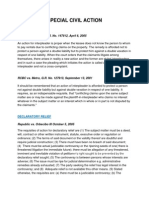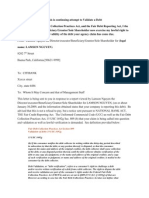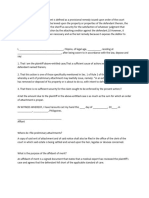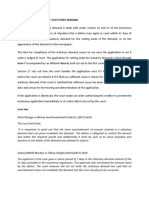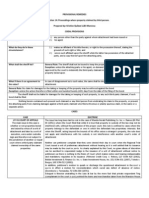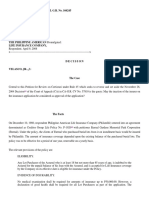January 2014 - Arizona Attorney Article
January 2014 - Arizona Attorney Article
Uploaded by
Amber GreenCopyright:
Available Formats
January 2014 - Arizona Attorney Article
January 2014 - Arizona Attorney Article
Uploaded by
Amber GreenCopyright
Available Formats
Share this document
Did you find this document useful?
Is this content inappropriate?
Copyright:
Available Formats
January 2014 - Arizona Attorney Article
January 2014 - Arizona Attorney Article
Uploaded by
Amber GreenCopyright:
Available Formats
I
ts a story that many lawyers know. Your personal injury case has finally settled, and the money is in your trust account to be disbursed. The client, who has been anxiously awaiting the settlement, needs their portion of the proceedsyesterday. They have bills to pay, mouths to feed, and they want to move on with their lives. But before disbursement takes place, a putative creditor chimes in and claims an interest in the money. To make matters more complicated, this creditors claim is, in whole or in part, illegitimate or unenforceable for some reason. Personal injury lawyers know that this is a common problem. Meanwhile, the client is calling repeatedlyto tell you to ignore the putative creditor and hand over the money. After all, they remind you, it is their money. But you cannot get the putative creditor to acknowledge that their claim is illegitimate or unenforceable. Or, as is unfortunately the case, perhaps they are simply making the illegitimate or unenforceable claim knowingly in order to demand a nuisance payment to go away. To comply with your clients direction, however, you would have to conclude that the putative creditor doesnt have a matured legal or equitable claim. This is frequently not possible and exposes the lawyer to being second-guessed at a later ethical inquiry if the decision is incorrect. So there you are, stuck in the middle between your client, to whom you owe all attorneyclient duties, and the putative creditor, for whom you are required to safeguard the fundsif you are unwilling to decide that the putative creditor does not have a matured legal or equitable claim to the settlement funds. The proverbial rock and a hard place. What are your traditional options?
Assess the putative creditors claim and make the determination as to whether the creditor has a matured legal or equitable claim. If you call it wrong, you have an angry client or angry putative creditor, either of whom may file a bar complaint. File an interpleader or declaratory relief action, which requires you to file a claim against your client and/or against your clients interests. Agree, with the clients consent, to pay the putative creditor to go away. Effective January 1, 2014, you have another tool. The Arizona Supreme Court has given lawyers a whole new mechanismunique among jurisdictionsfor dealing with third-party claims to client property. ER 1.15 now directs a lawyer to hold disputed property until the parties reach an agreement on the distribution of that property; a court order resolves the competing claims; orthis is the new partdistribution is allowed under the new mechanism. That new mechanism is outlined in ER 1.15(f), which allows a lawyer to serve a written notice upon the third party that the lawyer will distribute the property to the client unless the third party initiates legal action and provides the lawyer with written notice of such action within 90 calendar days. If the third party does not provide timely written notice of a legal action and, assuming disbursement
New Tool Addresses Third-Party Claims to Client Funds
BY GEOFF TRACHTENBERG & PATRICIA SALLEN
GEOFF TRACHTENBERG is managing partner of the California and Utah offices of Levenbaum Trachtenberg and a member of the State Bar Board of Governors. PATRICIA SALLEN is the State Bars Director of Ethics and Special Services and Deputy General Counsel.
30
A R I Z O N A AT T O R N E Y J A N U A R Y 2 0 1 4
is not prohibited by law or court order, the lawyer may ethically disburse the property to the client. The new mechanism came about as the result of a rule-change petition Geoff Trachtenberg, David Abney and Thomas Ryan filed that sought to resolve the impossible positionbetween client and third partythat many lawyers found themselves having to address. It is particularly apropos where a third-party makes an illegitimate or unenforceable claim to client proceeds.
claimed interests of which you have become aware. The mechanism can be used where there is or might be a matured legal or equitable claim without having to make such a determination. When should you send the ER 1.15(f) notice? Any time you identify a third-party claim against your clients proceeds that you believe, in whole or in part, is illegitimate or unenforceable for any reason. Or any time you believe a third-party claim is not a matured legal or equitable claim. What else should you know about ER 1.15(f) notices? First, this is a change to an ethical rule. ER 1.15(f) only provides a mechanism to allow lawyers to avoid ethical complaints. Using the mechanism will not protect you if you have a legal obligation to hold the property. ER 1.15(f)(4) (Nothing in this rule is intended to alter a third partys substantive rights). Second, if the disbursement is prohibited by law or court order, then even if you send the ER 1.15(f) notice, you cannot ethically disburse the money to your client. ER 1.15(f)(2) (If the lawyer does not receive such written notice from the third party within the 90-day period, and provided that the disbursement is not prohibited by law or court order, the lawyer may distribute ). And third, although the rule does not require you to make a written determination that a claim is illegitimate, unenforceable or is otherwise not a matured legal or equitable claim, you should not use the mechanism to intentionally avoid paying legitimate claims. Intentional abuse of ER 1.15(f) notices could lead to violations of other ethical rules.
Why This Is a Big Deal
First, it means that lawyers do not ethically have to make the legal determination as to whether the third party has a matured legal or equitable claim. Thats a standard that is not easy to define. In fact, it appears to have originated by way of a passing reference in an ethics treatise and has never been clearly defined. Second, it means that lawyers hands are not tied in situations where a third party is improperly demanding proceeds but is unwilling to take any action to prosecute its claim (likely because they know the claim is meritless). And third, it means that lawyers need not go to the expense of filing suit against the third parties over claims that are unmeritorious only to have the third parties drop the claim or default in the actionthings that further diminish client funds and delay distribution. When could you send the ER 1.15(f) notice? Any time there is a lien, subrogation or other third-party claim. The mechanism could be used with claims that you previously have acknowledged or other
The Arizona Supreme Court has given lawyers a whole new mechanism unique among jurisdictions.
directs that the notice must inform the third party that the lawyer may distribute the property to the client unless the third party initiates legal action and provides the lawyer with written notice of such action within 90 calendar days of the date of service of the lawyers notice. ER 1.15(f)(3) directs that if the lawyer is notified as required, the lawyer must continue to hold the property separate unless the parties reach an agreement on distribution or a court resolves the matter. And second, a new comment to the rule outlines what should be included at a minimum: Although there is no one form of notice that will be acceptable, the notice should generally include at least the following: (a) a description of the funds or property in the lawyers possession; (b) the name of the client claiming an interest in the funds and other information reasonably available to the lawyer that would allow the third person to identify the claim or interest; (c) a mailing address, telephone number, and email address where the third party can provide notice to the lawyer of the commencement of an action asserting an interest in the funds or property; and (d) the proposed distribution of the funds or property. The notice shall be served in the manner provided under Rules 4.1 or 4.2 of the Arizona Rules of Civil Procedure.
(Emphasis added.)
Conclusion
NUTTAPONG SHUTTERSTOCK.COM
The new ER 1.15(f) is intended to extricate the lawyer from between the proverbial rock and a hard place by shifting the burden to file lawsuits over these disputes from the clients and their lawyers to the third parties claiming rights to money. In short, lawyers What should the ER 1.15(f) notice look will be able to ethically tell third parties to like? act or else the money will be disbursed to the First, track the rule itself. ER 1.15(f)(1) client. AZ AT
J A N U A R Y 2 0 1 4 A R I Z O N A AT T O R N E Y
31
You might also like
- How To Sue Creditors in Small Claims Court & Win Without A Lawyer.Document8 pagesHow To Sue Creditors in Small Claims Court & Win Without A Lawyer.Minister100% (11)
- Complaint Letter Against An AttorneyDocument5 pagesComplaint Letter Against An Attorneyahryah ce'an el100% (1)
- The 5 Elements of the Highly Effective Debt Collector: How to Become a Top Performing Debt Collector in Less Than 30 Days!!! the Powerful Training System for Developing Efficient, Effective & Top Performing Debt CollectorsFrom EverandThe 5 Elements of the Highly Effective Debt Collector: How to Become a Top Performing Debt Collector in Less Than 30 Days!!! the Powerful Training System for Developing Efficient, Effective & Top Performing Debt CollectorsRating: 5 out of 5 stars5/5 (1)
- Initial Texas Probate FilingDocument18 pagesInitial Texas Probate FilingFred100% (2)
- Florida Banker's Association - Lost Notes 09-1460 - 093009 - Comments (Fba) 1Document9 pagesFlorida Banker's Association - Lost Notes 09-1460 - 093009 - Comments (Fba) 1A. CampbellNo ratings yet
- Default Judgments in Civil LawsuitsDocument19 pagesDefault Judgments in Civil Lawsuitskristin83% (6)
- Motion For Reconsideration and DismissalDocument6 pagesMotion For Reconsideration and Dismissaljason14dizonNo ratings yet
- Combating Bad-Faith Litigation Tactics With Claims For Abuse of Process SpohnDocument9 pagesCombating Bad-Faith Litigation Tactics With Claims For Abuse of Process SpohnCésar E. Moreno More100% (2)
- Palatino V ComelecDocument2 pagesPalatino V ComelecMaku PascualNo ratings yet
- 2 - Martelino v. NHMFCDocument23 pages2 - Martelino v. NHMFCEmary GutierrezNo ratings yet
- In Terp LeaderDocument2 pagesIn Terp LeaderannepidlaoanNo ratings yet
- Notice of Rescission or NullificationDocument3 pagesNotice of Rescission or Nullificationresearcher3100% (4)
- IntroductionDocument11 pagesIntroductionNaveen SihareNo ratings yet
- LCDocument4 pagesLCRetro gradeNo ratings yet
- RULE 62 InterpleaderDocument6 pagesRULE 62 InterpleaderbubblingbrookNo ratings yet
- A Quick Guide To Civil Proceedings in England and Wales: Solomon Taylor & Shaw SolicitorsDocument4 pagesA Quick Guide To Civil Proceedings in England and Wales: Solomon Taylor & Shaw SolicitorsctzhangjunweiNo ratings yet
- SCA TSN Rules 62-66Document16 pagesSCA TSN Rules 62-66luidkinniNo ratings yet
- Affirmative Defenses - Defenses To Use in Debt LawsuitsDocument3 pagesAffirmative Defenses - Defenses To Use in Debt LawsuitsWarriorpoet0% (1)
- Answers 4 - 6-1Document14 pagesAnswers 4 - 6-1Usenathi PhindeloNo ratings yet
- Civil Procedure Q's and Answers DocumentDocument63 pagesCivil Procedure Q's and Answers DocumentUsenathi PhindeloNo ratings yet
- Article 2 - Effectivity of Laws Tanada v. Tuvera 136 SCRA 27Document50 pagesArticle 2 - Effectivity of Laws Tanada v. Tuvera 136 SCRA 27Truman TemperanteNo ratings yet
- Lim Tanhu vs. RamoleteDocument40 pagesLim Tanhu vs. RamoleteCassieNo ratings yet
- de Joya Vs MarquezDocument4 pagesde Joya Vs MarquezMelo Ponce de LeonNo ratings yet
- Case DigestDocument25 pagesCase DigestGeoff Contreras0% (1)
- Code of Civil Procedure Project On Topic - Interpleader SuitDocument5 pagesCode of Civil Procedure Project On Topic - Interpleader Suitsinistro CFCNo ratings yet
- Interpleader Suit CPCDocument8 pagesInterpleader Suit CPCjangrasahil1613No ratings yet
- Balance of ConvenienceDocument5 pagesBalance of ConvenienceZiyad Rv100% (2)
- Lim Tan Hu vs. RamoleteDocument47 pagesLim Tan Hu vs. RamoleteJan SantosNo ratings yet
- Case 3:12-cv-00519-GCM Document 183 Filed 01/06/14 Page 1 of 6Document6 pagesCase 3:12-cv-00519-GCM Document 183 Filed 01/06/14 Page 1 of 6jmaglich1No ratings yet
- 15 Litigation Funding Good orDocument9 pages15 Litigation Funding Good orTinnok TangNo ratings yet
- Legal EthicsDocument5 pagesLegal EthicsArjane Aram SamaniegoNo ratings yet
- Chester de Joya V Judge Placido Marquez, G.R. No. 162416 - January 31, 2006Document3 pagesChester de Joya V Judge Placido Marquez, G.R. No. 162416 - January 31, 2006ademarNo ratings yet
- Jaime S. Domdom vs. SandiganbayanDocument3 pagesJaime S. Domdom vs. Sandiganbayanvanessa3333333No ratings yet
- Who in Identity Theft Needs A LawyerDocument8 pagesWho in Identity Theft Needs A LawyerRizky Amalia PutriNo ratings yet
- Filing Complaint For Writ of ReplevinDocument2 pagesFiling Complaint For Writ of ReplevinRodelyn Azuero100% (1)
- Debt Validation Letter Incomplete 2012Document9 pagesDebt Validation Letter Incomplete 2012minosnada100% (2)
- 4 - Quesada v. DOJDocument3 pages4 - Quesada v. DOJMiguel ManzanoNo ratings yet
- Business Law 1Document12 pagesBusiness Law 1api-336448348No ratings yet
- AFFIDAVITDocument14 pagesAFFIDAVITLeorebelle Racelis100% (1)
- Insha KhanDocument9 pagesInsha KhanIsba KhanNo ratings yet
- LLB 5TH Sem CPC Unit 3Document15 pagesLLB 5TH Sem CPC Unit 3Duby ManNo ratings yet
- 2013-2014 Remedial CasesDocument42 pages2013-2014 Remedial CasesRaymund Christian Ong AbrantesNo ratings yet
- General Rules of PleadingsDocument6 pagesGeneral Rules of PleadingsBhoomika KeshavanNo ratings yet
- Chapter 4 - Solution ManualDocument17 pagesChapter 4 - Solution ManualjuanNo ratings yet
- 16-1149 U.S. Third Circuit Appeal MOTION To RECONSIDER Order of February 16, 2016 Re LAMBERT Habeus Corpus March 15, 2016Document8 pages16-1149 U.S. Third Circuit Appeal MOTION To RECONSIDER Order of February 16, 2016 Re LAMBERT Habeus Corpus March 15, 2016Stan J. CaterboneNo ratings yet
- EvidenceDocument4 pagesEvidenceRea Jane B. MalcampoNo ratings yet
- Legal Memorandum ExampleDocument11 pagesLegal Memorandum ExampleBrianna KayNo ratings yet
- Cease and DesistDocument6 pagesCease and DesistAllen Kaul100% (6)
- CIVIL S10 SA14B Pre Action Disclosure Transcript LM3Document4 pagesCIVIL S10 SA14B Pre Action Disclosure Transcript LM3haurin.kamalNo ratings yet
- de Joya vs. Judge Placido C. Marquez, G.R. No. 162416, SupraDocument4 pagesde Joya vs. Judge Placido C. Marquez, G.R. No. 162416, SupraAbhor TyrannyNo ratings yet
- Jurisprudence For Lift DefaultDocument6 pagesJurisprudence For Lift DefaultSandyNo ratings yet
- Application To Set Aside Statutory DemandDocument4 pagesApplication To Set Aside Statutory DemandLennox Allen Kip100% (1)
- My Ethics TemplatesDocument52 pagesMy Ethics TemplatesAlejandro CuevasNo ratings yet
- Civ Pro AnswersDocument2 pagesCiv Pro AnswersNeil FrangilimanNo ratings yet
- Presentation - The Appointment of the Receiver.Document12 pagesPresentation - The Appointment of the Receiver.pleasurekillsNo ratings yet
- Rule 57 Sections 15-17 Case Doctrine SummaryDocument15 pagesRule 57 Sections 15-17 Case Doctrine SummarytintintinkyuNo ratings yet
- GarnishmentDocument4 pagesGarnishmentgonzalesmarkjd77No ratings yet
- Avoiding Workplace Discrimination: A Guide for Employers and EmployeesFrom EverandAvoiding Workplace Discrimination: A Guide for Employers and EmployeesNo ratings yet
- Drafting Legal Notices in India: A Guide to Understanding the Importance of Legal Notices, along with DraftsFrom EverandDrafting Legal Notices in India: A Guide to Understanding the Importance of Legal Notices, along with DraftsRating: 1 out of 5 stars1/5 (2)
- Betty Gabionza and Isabelita Tan vs. Court of Appeals GR No. 161057 September 12, 2008 FactsDocument24 pagesBetty Gabionza and Isabelita Tan vs. Court of Appeals GR No. 161057 September 12, 2008 Factsdwight yuNo ratings yet
- The Indian Parliament EngDocument100 pagesThe Indian Parliament EngDev choudharyNo ratings yet
- DACV - Temporary Protective OrderDocument10 pagesDACV - Temporary Protective OrderthesacnewsNo ratings yet
- Case Analysis of Harishchandra HegdeDocument2 pagesCase Analysis of Harishchandra HegdeLisha ChandrakarNo ratings yet
- Third Division: L/epttblic of Tbe TlbilippinetiDocument8 pagesThird Division: L/epttblic of Tbe TlbilippinetiBeboy Paylangco EvardoNo ratings yet
- Leon County Sheriff'S Office Daily Booking Report 24-Oct-2020 Page 1 of 2Document2 pagesLeon County Sheriff'S Office Daily Booking Report 24-Oct-2020 Page 1 of 2WCTV Digital Team100% (2)
- 36 55 CaseDocument101 pages36 55 CaseAnonymous SBT3XU6INo ratings yet
- Counter Appeal MemorandumDocument14 pagesCounter Appeal MemorandumAntonio de VeraNo ratings yet
- Adverse Claim - GRN 229408 CRDC PDFDocument68 pagesAdverse Claim - GRN 229408 CRDC PDFJoAnneGallowayNo ratings yet
- Philippine Guardians Brotherhood, Inc. (PGBI) V COMELEC G.R. No. 190529, 20 April 2010Document3 pagesPhilippine Guardians Brotherhood, Inc. (PGBI) V COMELEC G.R. No. 190529, 20 April 2010Yoo Si JinNo ratings yet
- 6-13 Apcd v. Pca, G.R. No. 110526, February 10, 1998Document24 pages6-13 Apcd v. Pca, G.R. No. 110526, February 10, 1998Reginald Dwight FloridoNo ratings yet
- Consti1 Mod1Part2Document1 pageConsti1 Mod1Part2RENER JEIEL BORAISNo ratings yet
- Alunan Vs Mirasol G.R. No. 108399 CASE DIGEST PDFDocument1 pageAlunan Vs Mirasol G.R. No. 108399 CASE DIGEST PDFJoannMarieBrenda delaGenteNo ratings yet
- Iloilo City v. Legaspi, GR 154614. Nov. 25, 2004, 444 SCRA 269Document1 pageIloilo City v. Legaspi, GR 154614. Nov. 25, 2004, 444 SCRA 269Baisy VillanozaNo ratings yet
- Con Law OutlineDocument14 pagesCon Law OutlineAndrew ButlerNo ratings yet
- People vs. Puedan, 388 SCRA 226, G.R. No. 139576, September 2, 2002Document9 pagesPeople vs. Puedan, 388 SCRA 226, G.R. No. 139576, September 2, 2002Olga Pleños ManingoNo ratings yet
- HARIHAR To Asst US Attorney Mary Murrane, "You Have Witnessed An Act of Treason Firsthand."Document27 pagesHARIHAR To Asst US Attorney Mary Murrane, "You Have Witnessed An Act of Treason Firsthand."Mohan HariharNo ratings yet
- 134 Roque Vs IACDocument1 page134 Roque Vs IACKirsten Denise B. Habawel-VegaNo ratings yet
- Antonio Vs Reyes GR 155800, March 10, 2006Document2 pagesAntonio Vs Reyes GR 155800, March 10, 2006Elvis Jagger Abdul JabharNo ratings yet
- Victim: A Forgotten Story in The Indian Criminal Justice SystemDocument22 pagesVictim: A Forgotten Story in The Indian Criminal Justice SystemVimleshNo ratings yet
- Danilo LimDocument1 pageDanilo LimVERA FilesNo ratings yet
- Charles Larry Jones v. United States, 224 F.3d 1251, 11th Cir. (2000)Document13 pagesCharles Larry Jones v. United States, 224 F.3d 1251, 11th Cir. (2000)Scribd Government DocsNo ratings yet
- EO 277 - Amending Sect 68 of PD 705Document2 pagesEO 277 - Amending Sect 68 of PD 705Mayette Rose Sarroza100% (1)
- People v. BarrosDocument14 pagesPeople v. BarrosRaymundNo ratings yet
- Aytona Vs CastilloDocument19 pagesAytona Vs CastilloSapphireNo ratings yet
- Asad Malik PRJDocument19 pagesAsad Malik PRJSufi GhyassuddinNo ratings yet
- A.M. No 02-11-10Document6 pagesA.M. No 02-11-10Nico de la PazNo ratings yet
- Death PenaltyDocument14 pagesDeath PenaltyCleiz Pardilla100% (1)
- Article 1723Document3 pagesArticle 1723Brian Ernest RegaladoNo ratings yet























